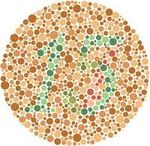LearningActivities ColorBlindness
From Socr
| Line 22: | Line 22: | ||
* To estimate the probability that a randomly selected woman is colorblind, you might use the proportion of colorblind women in a sample of n women. What is the variance of this estimator? | * To estimate the probability that a randomly selected woman is colorblind, you might use the proportion of colorblind women in a sample of n women. What is the variance of this estimator? | ||
| - | |||
| - | |||
{{hidden| See the Answer| \(X_f\)~\(Binomial(n,p^2)\). | {{hidden| See the Answer| \(X_f\)~\(Binomial(n,p^2)\). | ||
| - | Thus \(Var(\frac{X_f}{n}) | + | Thus \(Var(\frac{X_f}{n}) \equiv \frac{p^2(1-p^2)}{n}\). }} |
* Alternatively, to estimate the probability that a randomly selected woman is colorblind, you might use the square of the proportion of colorblind men in a sample of n men. Explain why this estimate makes sense. What is the variance of this estimator? | * Alternatively, to estimate the probability that a randomly selected woman is colorblind, you might use the square of the proportion of colorblind men in a sample of n men. Explain why this estimate makes sense. What is the variance of this estimator? | ||
{{hidden| See a Hint| The moment generating function can be used to find the fourth moment about the origin. }} | {{hidden| See a Hint| The moment generating function can be used to find the fourth moment about the origin. }} | ||
| - | {{hidden| See the Answer| We want to estimate \(p^2\) and \(\frac{X_m}{n}\) estimates \(p\) so it makes sense to use \((\frac{X_m}{n})^2\) as the estimator (in fact it will be the [http://wiki.stat.ucla.edu/socr/index.php/AP_Statistics_Curriculum_2007_Estim_MOM_MLE#Maximum_Likelihood_Estimation_.28MLE.29 maximum likelihood estimate]). We have \(Var[( \frac{X_m}{n} )^2 ] | + | {{hidden| See the Answer| We want to estimate \(p^2\) and \(\frac{X_m}{n}\) estimates \(p\) so it makes sense to use \((\frac{X_m}{n})^2\) as the estimator (in fact it will be the [http://wiki.stat.ucla.edu/socr/index.php/AP_Statistics_Curriculum_2007_Estim_MOM_MLE#Maximum_Likelihood_Estimation_.28MLE.29 maximum likelihood estimate]). We have \(Var[( \frac{X_m}{n} )^2 ] \equiv n^{-4}[E(X_m^4 ) - (E(X_m^2 ))^2 ]\). Take \(q \equiv 1-p\). Then the fourth moment about the origin of a binomial is \(E(X^4) \equiv np(q-6pq^2+7npq-11np^2q+6n^2p^2q+n^3p^3)\) and the second moment is \(E(X^2) \equiv np(q+np)\). Thus \(Var[( \frac{X_m}{n} )^2 ] \equiv n^{-3}(pq + 6(n-1)p^2q^2 + 4n(n-1)p^3q)\). }} |
* For large samples, is it better to use a sample of men or a sample of women to estimate the probability that a randomly selected women is colorblind? Explain. | * For large samples, is it better to use a sample of men or a sample of women to estimate the probability that a randomly selected women is colorblind? Explain. | ||
{{hidden| See a Hint| Show that a normal approximation is valid for both and then compare the variances.}} | {{hidden| See a Hint| Show that a normal approximation is valid for both and then compare the variances.}} | ||
| - | {{hidden| See the Answer| For large n the ratio of the variances for the estimate in part c to the estimate in part d is \(\frac{Var(\frac{X_f}{n})}{Var((\frac{X_m}{n})^2 )} \sim \frac{p^2(1-p^2)}{4p^3q} | + | {{hidden| See the Answer| For large n the ratio of the variances for the estimate in part c to the estimate in part d is \(\frac{Var(\frac{X_f}{n})}{Var((\frac{X_m}{n})^2 )} \sim \frac{p^2(1-p^2)}{4p^3q} \equiv \frac{1+ p}{4p}\). When this ratio is greater than 1, the estimator based on the sample of men will be better. Since this happens for any \(p < \frac{1}{3}\), which is clearly the case for colorblindness, it is better to use a sample of men to estimate the probability that a random woman is colorblind.}} |
===Alternate approach=== | ===Alternate approach=== | ||
Current revision as of 19:53, 17 November 2011
Contents |
Distributome Learning Activities - Distributome Colorblindness Activity
Overview
This Distributome Activity illustrates an application of probability theory to study Colorblindness.
Colorblindness results from an abnormality on the X chromosome. The condition is thus rarer in women since a woman would need to have the abnormality on both of her X chromosomes in order to be colorblind (whether a woman has the abnormality on one X chromosome is essentially independent of having it on the other).
Goals
The goal of this activity is to demonstrate an efficient protocol of estimating the probability that a randomly chosen individual may be colorblind.
Hands-on Activity
Suppose that \(p\) is the probability that a randomly selected man is colorblind.
- 100 men are selected at random. What is the distribution of \(X_m\) = the number of these men that are colorblind?
- 100 women are selected at random. What is the distribution of \(X_f\) = the number of these women that are colorblind?
- To estimate the probability that a randomly selected woman is colorblind, you might use the proportion of colorblind women in a sample of n women. What is the variance of this estimator?
- Alternatively, to estimate the probability that a randomly selected woman is colorblind, you might use the square of the proportion of colorblind men in a sample of n men. Explain why this estimate makes sense. What is the variance of this estimator?
- For large samples, is it better to use a sample of men or a sample of women to estimate the probability that a randomly selected women is colorblind? Explain.
Alternate approach
You can also use the delta method to find the approximate variance for the estimator above.
Conclusions
In practice, it may difficult to obtain reliable parameter estimates when the event at hand is very rare (such as with colorblindness in women). The use of a valid probability model such as the relationship between the chance of colorblindness in men and the chance in women may improve these estimates.
Short link
Translate this page:

